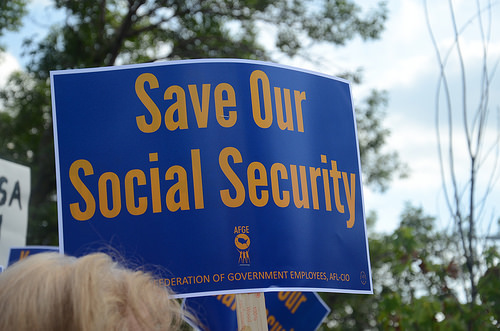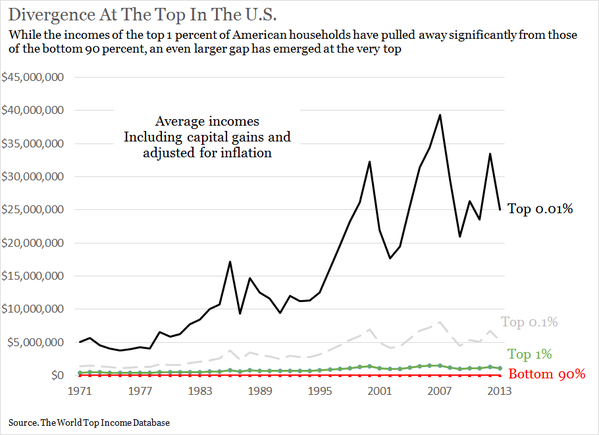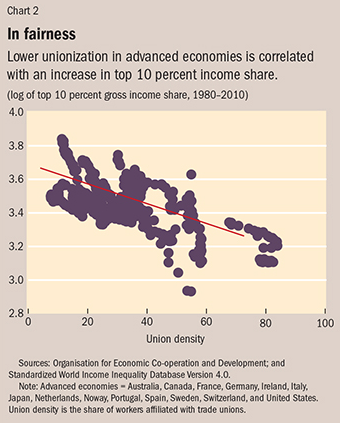
“The future of labor is the future of America,” labor leader John Lewis said, during the Great Depression.
And for a long time, you had to squint to see that future because it’s so bright. America capitalized on its enormous advantages after World War II with unprecedented growth that was — thanks to the labor movement — widely shared.
However, workers wages peaked in the 1970s and since then, gains have been widely shared by the richest .01 percent.

Some have argued that this is a mystic inevitability that is in no way connected to corporate America focusing its enormous power and wealth on an agenda of cutting taxes for the rich and deregulating industry. It’s just a coincidence that the massive divergence of wealth to the richest as we had a “40-year slump for workers” just happened to trace the systemic effort to undermine America’s labor unions.
Well, a new study shows that that about half the increase in global inequality looks to be a direct result of the war on labor.
A new study from the International Monetary Fund’s Florence Jaumotte and Carolina Osorio Buitron finds “strong evidence that lower unionization is associated with an increase in top income shares in advanced economies during the period 1980–2010.”

This echoes research by the Economic Policy Institute which has connected the decline of union density with the acceleration of Inequality in the United States.
Economists argue that some inequality is good for increasing economic incentives. But the yawning inequality of the last three decades lowers overall economic growth and the runaway accumulation of wealth on top allows top earners to manipulate the political system, creating a vicious cycle of policies that hurt the those who need help most. These policies are ultimately bad for business, which is why everyone does better when we have a Democratic president.
Collectively labor acts as the first — and often only — as the lobbyist for the working class. It’s played a key role in the passage of Social Security, Medicare, Medicaid and Obamacare. By systematically undermining it, the Democratic Party is drained of money and volunteers and, ultimately, voters. Without its support the left is forced to seek assistance from the same sources as the Republican Party, sources that have an Prime Directive of decreasing workers bargaining power thus wages.
When Scott Walker promises to bring his anti-union policies that have help lead Wisconsin to the largest decline in the Middle Class of any state nationally, he’s revealing what’s long been the subtext of the conservative movement. Their goal has always been to trick the middle class to vote itself out of existence, and this requires turning workers against backbone that gives them the ability to stand up to corporate power — unions.
Despite the right’s ability to influence lawmakers and the media, labor is showing new signs of life thanks to efforts like Fight for $15.
“In a Pew Research Center poll in March, people viewed unions favorably by 48 percent to 39 percent,” Jill Lawrence wrote in the National Memo. “Even more encouraging, support for the right to organize in specific sectors was as high as 82 percent and the age group most supportive of unions was 18 to 29. Polls and election results alike suggest labor has a future, if it can keep it.”
Essential to this is understanding that how we talk about unions matters. Making workers resentful and jealous of the few of their peers who still have pensions and other elements of job security is key to undermining the most important role unions play as the only advocate of working people who can stare down the corporate America, which has largely copied labor’s organizational efforts with greater resources and results than workers could have ever mustered.
In the name of education reform, many well intentioned liberals have aligned with conservatives, willingly ignoring that part of the right’s agenda in undermining public schools — destroying the power of teachers’ unions. Expecting schools to fix poverty by embracing policies that ultimately increase inequality is insanity.
Embracing labor and greater workplace representation as central to reversing the wealth gap that threatens our economy and stability is the “one thing” that can save us as labor attorney Thomas Geoghegan argues in his great new book.
This starts by changing how we talk about unions. George Lakoff reminds us to always put their necessity in terms of the value that matters most to Americans: “Unions are about freedom, freedom from corporate servitude and wage slavery, freedom from unsafe working conditions, and the freedom in later life that comes from fair pensions, which are delayed payments for work done earlier in life.”
Studies show this isn’t just good framing. It’s good economics.
[Top .01% chart courtesy of Mark Price. Photograph via AFGE | Flickr]



